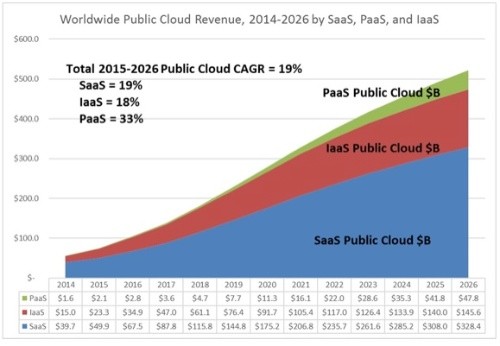Cloud, cloud, cloud. That’s all you seem to hear these days in the storage world. So is cloud storage going to be the way of the future or will cloud storage problems see a return to a focus of on premise storage?
Public Cloud Storage Grows
Jim Liddle, CEO of Storage Made Easy, expects the public cloud to continue to grow and on-premise storage to shrink but not disappear. But he thinks the decision of what to move to the public cloud is data sensitive. Less sensitive data will be the first to go and then more sensitive information will find its way there as confidence grows concerning the security side of the public cloud.
This view of the public cloud is shared by Ralph Finos, an analyst at Wikibon. He thinks that the public cloud will account for nearly 50% of spending on enterprise hardware, software and outsourcing services by 2016. That’s a 19% growth rate per year average for each year of the next decade.
“Almost all new software startups and most big software vendors are driving hard at the public cloud,” said Finos. “Traditional software providers are aggressively transitioning to subscription and cloud models.”
Fewer Clouds
Liddle also sees vendor consolidation as being an important factor going forward. Many players have burst onto the scene offering public cloud storage. There have been some notable failures already and more are likely as the market pares down to only a few vendors.
“The market will boil down to fewer vendors over time, as the cost and scale of Amazon forces others to do the same,” said Liddle. “It takes real size to deal with the economies of scale of the big vendors. Rather than compete, companies are looking more to partner with Amazon and others.”
That means the likes of Amazon, Microsoft Azure and Google are likely to dominate and smaller competitors will either be edged out, will be acquired, or will settle into a specific niche.
Clouds Differ
A cursory look upwards will quickly make it clear that clouds are not all alike. It’s the same with the public cloud. Each has its own cost structure, additional charges, advantages, disadvantages and suitability for storage of certain kinds of data.
“All cloud systems are not built alike to take advantage of total cost of ownership calculators and proof of concept labs to understand the key differences between the various cloud storage systems, technologies and use cases,” said Scott Cleland, Senior Director of Product Marketing, Western Digital Corporation. “Understanding of factors such as software alliances, eco-system partners, an established heritage in reliable storage and an ability to offer a broad spectrum of education and products, can be useful in building a more complete picture.”
Multiple Clouds
Paul Turner, Chief Marketing Officer (CMO) at Cloudian, thinks that no matter what happens, companies are unlikely to put all their data in one cloud basket.
“It won’t be a single cloud,” he said. “There will be internal clouds, some data on Amazon and some on other public clouds.”
But such an arrangement brings up a major cloud storage problem of how you manage across multiple clouds efficiently. It’s just not that easy right now to move data between clouds, how do you move apps around, how do you accomplish cost management and deal with thorny issues such as access control?
“You are likely to see abstraction layers above the cloud to manage multiple clouds and Amazon will be on the forefront,” said Turner. Microsoft Azure and OpenStack are also trying to move in that direction. But storage management remains an essential part of the cloud and cloud management.
Mind The Gap
Barry Phillips, CMO at Panzura, advises users to mind the gap between the public cloud and the enterprise.
“People want to lift and shift enterprise apps in order to run efficiently in the cloud,” said Phillips. “We need to have the ability to run apps in the cloud or on premise while using the same data.”
A bridge between on premise and the cloud, then, is an essential part of workable storage going forward.
Hybrid Or Private?
Some, particularly SMBs, will go all cloud. Others will adopt a hybrid cloud model and still others will favor a private cloud that only they control. Interestingly, Phillips thinks the allure of the public cloud may eventually fade. The economics of it are fine up to certain doses but if everything goes in, the current data growth rate continues and the necessary enterprise storage features are added to the cloud, prices are likely to soar.
“Eventually, it may turn out to be cheaper to run in a private cloud rather than a public cloud,” he said.
Regulatory Push Back
Deepak Mohan, analyst at IDC, brought up internal policy, regulatory restrictions, and security concerns as reasons why the rush to the cloud may be tempered, particularly for large enterprises. He said that the public cloud could be used to host more organizational data. However, the current policy, regulatory and security considerations, in many cases, preclude the use of public cloud assets. This will have to change if cloud expansion is to continue.
“As the cloud continues to grow, the policy and regulatory framework will need to evolve to better cater to public cloud utilization,” said Mohan. “This will unlock more categories of workload for deployment on the public cloud.”
This, though, is less of a concern to SMBs that operate in less regulated sectors and are less shackled by policy. For them, cost is the primary concern. As their cloud usage grows, the pay as you use model might not scale with time.
“We need better ways of assessing true costs in the cloud as some are complaining about not being able to predict the costs accurately,” said Mohan. “One way to address this is by being more targeted in the selection of public cloud storage options such as lower availability services for cold data.”
Bright Skies
As for the future, Mohan said on premise infrastructure growth is at least slowing down (IDC numbers put its growth rate at around 1% per year for the next five years). Cloud storage, he said, represents the biggest current growth engine in the storage world.
“We see enterprises starting new apps and deployments in the cloud with the intent of eventually switching off some of their in house storage,” said Mohan. “There are also a growing number of services that are making integration of cloud and in-house storage easier. With changes in policy and increasing ease of integration, you can expect to eventually see public cloud storage grow to match and overtake in-house storage capacity managed by enterprises.”







